#itihasa
Text
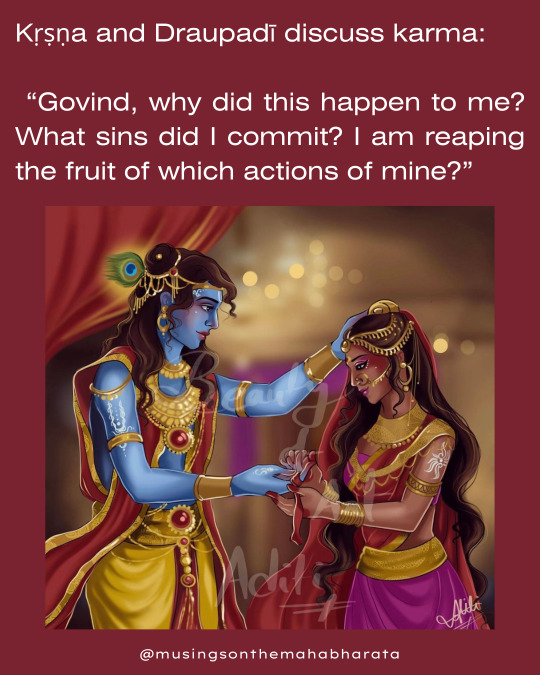
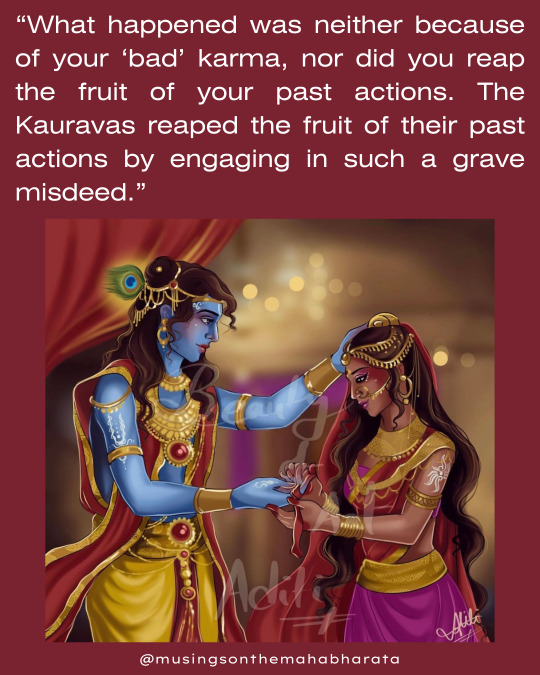
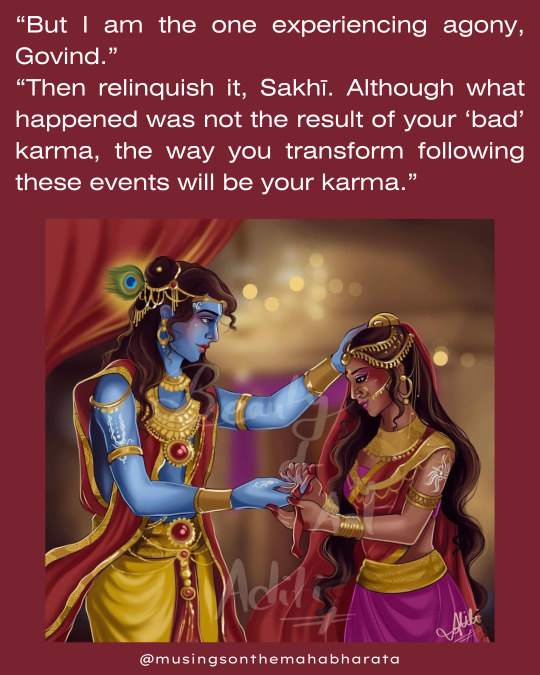
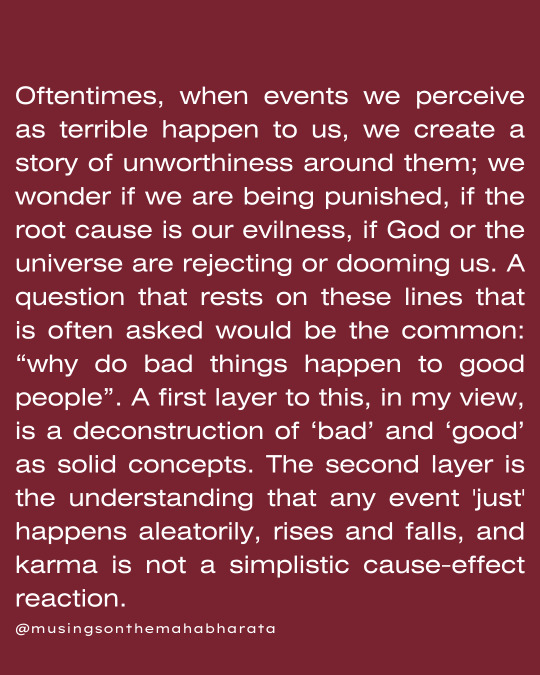
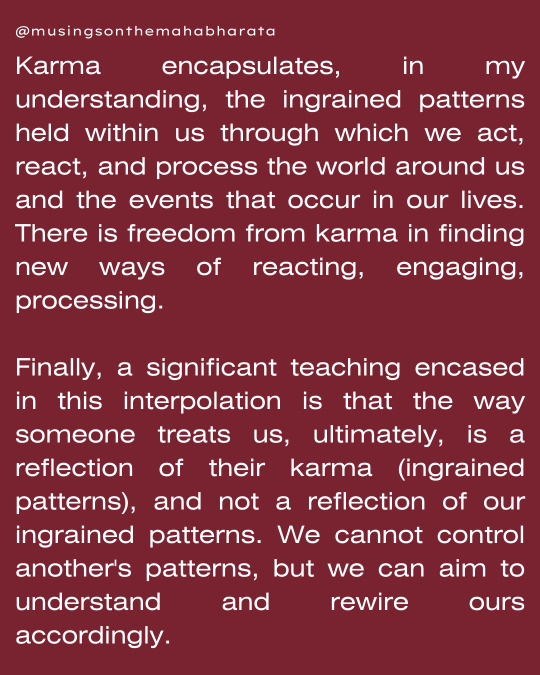
Kṛṣṇa and Draupadī Discuss Karma
One of my favourite interpolations from modern tellings of the Mahābhārata is a conversation between Draupadī and Kṛṣṇa that occurs after Draupadī's sexual assault and attempted disrobing by the Kauravas.
Clutching his feet, Draupadī sobs: "Govind, why? Why did this happen to me? What sins did I commit? I am reaping the fruit of which actions of mine?”
Picking her up and caressing her hair, Arya tells her: "What happened was neither because of your ‘bad’ karma, nor did you reap the fruit of your past actions. It was the Kauravas who reaped the fruit of their past actions by engaging in such a grave misdeed. Sakhī, this is the meaning of karma."
"But I am the one experiencing agony, Govind."
"Then relinquish it, Sakhī. Although what happened was not the result of your 'bad' karma, the way you transform following these events will be your karma."
This is such a beautiful and profound exchange which offers rich nuances to the teaching of karma. Oftentimes, when events we perceive as terrible happen to us, we create a story of unworthiness around them; we wonder if we are being punished, if the root cause is our evilness, if God or the universe are rejecting or dooming us. A question that rests on these lines that is often asked would be the common: “why do bad things happen to good people”. A first layer to this, in my view, is a deconstruction of 'bad' and 'good' as solid concepts. The second layer is the understanding that any event 'just' happens aleatorily, rises and falls, and karma is not a simplistic cause-effect reaction.
Karma encapsulates, in my understanding, the ingrained patterns held within us through which we act, react, and process the world around us and the events that occur in our lives. There is freedom from karma in finding new ways of reacting, engaging, processing.
Finally, a significant teaching encased in this interpolation is that the way someone treats us, ultimately, is a reflection of their karma (ingrained patterns), and not a reflection of our ingrained patterns. We cannot control another's patterns, but we can aim to understand and rewire ours accordingly.
The magnificent art: @beauty_of_art_aditi.
#mahabharata#mahabharat#krishna#draupadi#sakhi#sakha#govind#govinda#hare krishna#mahabharatam#itihasa#hinduism#hindu art#yajnaseni#panchali#mahabharat star plus#hindu#hindu mythology#karma#spirituality#shri#teaching#freedom#mahabharata art#raksha bandhan#religion#sanskrit
128 notes
·
View notes
Text
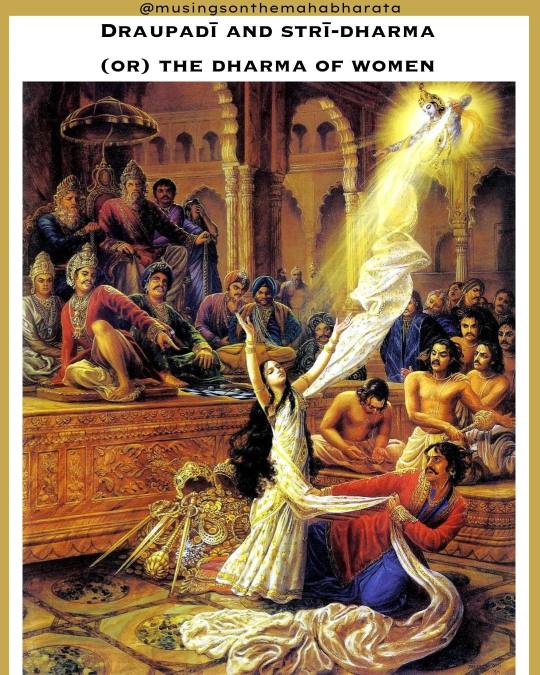
Draupadī and the Dharma of Women
"Strī" translates from Sanskrit as "woman", while "dharma" is a complex principle with manifold meanings, in this context bearing the significance of "duty"; in simple terms, it refers to an individual conduct that contributes to harmony in a greater framework, be it societal or cosmological.
Draupadī is lauded in the Critical Edition of the Mbh several times as being the epitome of strī-dharma, of the dharma of women. (2.62.20; 2.63.25-30; 2.64). Interestingly, she is most intensely praised as such after she angrily (yet elegantly!) questions the men of the royal court and demands justice, being anything but meek and demure. I would argue that this showcases that in the Mahābhārata voicing oneself and standing up for oneself are considered responsibilities belonging to the dharma of women.
To nuance this even more, Eknath Easwaran, an eminent translator of the Bhagavadgītā, highlights that, etymologically, the term "dharma" can be traced back to the root 'dhri', which means 'to support, hold up, or bear'; "dharma" therefore translates as "that which supports", and Draupadī's conduct therefore supports both society and cosmology.
In the Sanskrit Mbh, Kṛṣṇa does not appear in the sabhā (royal hall) at the time of Draupadī's attempted disrobing, and no direct mention of him is made during this episode. In a conversation with Dr. Brian Black, a Mbh researcher whom I had the honour to have as my MA supervisor, we talked about the implication of this, which is that Draupadī's adherence to strī-dharma appears to be that which shields her. A question that could arise here could be whether there is a contradiction between the Critical Edition and modern renderings of the Mahābhārata, with Draupadī being shielded by her dharma as opposed to by Kṛṣṇa.
For me there is no contradiction.
Kṛṣṇa in the Bhagavadgītā establishes himself as 'the eternal dharma' (14.27); and so, Kṛṣṇa is all dharmas, including strī-dharma. We tend to associate Kṛṣṇa with a fully-fledged incarnation; but he is beyond that. I would maintain that, as the divine principle, he exists in Draupadī's consciousness and in her actions as dharma (and not only!). The latter renditions, for me, in which he is physically there, only bring forth in tangible projections the internal process extending Draupadī's consciousness.
You can find me on IG: @musingsonthemahabharata.
Painting: Jadurani Dasi, 1986.
#mahabharata#mahabharat#draupadi#krishna#draupadi's disrobing#hindu art#mahabharatam#panchali#hindu mythology#hinduism#hindu#hindu philosophy#itihasa#sanskrit#phd#phd scholar#dharma#stri dharma#bhagavadgita#bhagavad gita#bhakti#vishnu
77 notes
·
View notes
Text
Indic academy initiative for publishing content on Shastraas, Indic Knowledge Systems & Indology and to showcase the activities of Indic Academy.
Visit us:
https://www.indica.today/
#Shastraas#Indic Knowledge Systems#Indology#Indic academy#Indica Today#Shastra#Shastrartha#Itihasa#Purana#Adhyayana#Svadhyaya#Pauranika#Yoga#Sankhya#Nyaya#Mimamsa#Tarka
0 notes
Video
youtube
Ramayana: The Legend of Prince Rama
This looks so cool. Its apparently a remake? of the Indian epic animated back in 1993.
youtube
17 notes
·
View notes
Text
Resources to learn more about Hinduphobia, and Hindu culture.
Making a masterpost about this because I'm getting a lot of asks for it. The list will be updated!
Books to read:
Not Without My Daughter by Betty Mahmoody. This is the memoir of a woman stuck in Iran and how she has to illegally sneak out with her daughter. It doesn't focus on Hinduphobia but it does highlight the violence perpetuated by Muslims to women. This is a true story and a movie has also been made on it. Also, I just need to appreciate how well it's written, I was on the edge of my seat the whole time.
Aavarna by S. L. Bhyrappa. This book basically details how Hindu history was derailed and destroyed by Mughal invaders, specifically Aurangzeb, the plot is fictional but the history is real.
All Religions Are Not the Same by Sanjay Dixit. This is a new book and I've just ordered it actually. It discusses the differences between religions and how secularism affects that.
Why I Killed Gandhi by Nathuram Godse. Includes the testimonial of the man who killed Gandhi. I'm about to read this book and I'm excited. Don't be fooled by the one-star reviews.
Some people you can follow on Twitter are Dr Anand Ranganathan, The Skin Doctor, and VivanVatsa. They're all well-read on Hinduphobia and/or Hindu history. Anand Ranganathan also has published books on Hinduphobia, like Hindus in Hindu Rashtra.
Blogs you can follow for awareness, and learning about Hinduphobia/Hindu culture:
@rhysaka (debunking common myths, awareness)
@magic-coffee /@vindhyavasini(debunking common myths, awareness, politics/geopolitics, news, culture)
@anjanadri (debunking common myths, awareness, culture)
@latent-thoughts (history and explanations, culture)
@forgotten-bharat (amazing for the history of ancient India, and culture)
@misalpav (culture, awareness)
Interesting masterposts from other blogs:
Booklist to learn more about Hindu History by @magic-coffee
The Ayodhya Masterpost by @magic-coffee
Some important Hindu literature:
Mahabharata
This is classified as an Itihasa text. It deals with a war between 2 royal factions and is a vehicle for describing the activities of the Avatar Krishna.
Ramayana
This is also an Itihasa text. It provides the biography of Lord Rama who is considered an Avatar of Vishnu.
Bhagavad Gita
This is an important text of the Vedanta school and is treated separately although it is part of Mahabharata. It provides a coherent summary of Vedanta.
Srimad Bhagavatam
This is a Purana and provides a biography of Lord Krishna. This is an important text for the Vaishnava sect of Hinduism.
Shiva Purana and Linga Purana
These Puranas provide the biography of Lord Shiva and are important texts for the Saivite sect of Hinduism.
Chandi or Devi Mahatmyam
This is an important text for Saktas who worship Sakti or Devi. This text is really part of the Markandeya Purana.
But really, the best way to combat Hinduphobia, is to learn about our history and culture, because if you know the truth, you won't fall for the twisted narrative being peddled by the media today. If you've got to the end of this, thank you for educating yourself and learning about us.

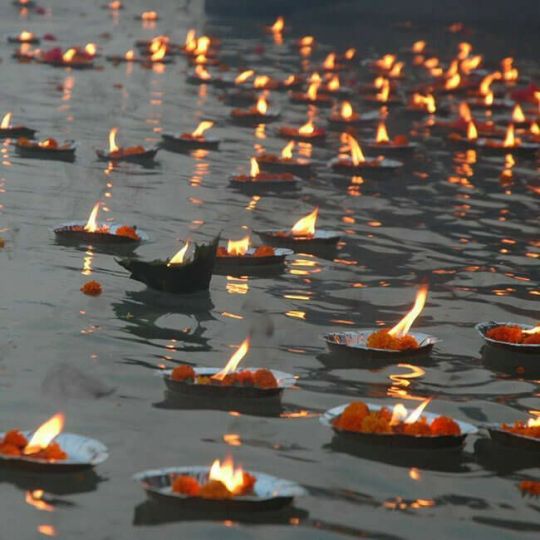
103 notes
·
View notes
Note
hello, this is may be incoherent or long so apologies.
how do you reconcile with subscribing to hinduism in any way despite the horrific violence and atrocities it propagates? i was raised hindu (but I’m now a staunch atheist) and i was never religious but like you all i did enjoy the myths and the characters in it. but that was before i became politically conscious and came to know about the suffering wreaked by the caste system and the insanity of hindutva. hindutva ideology is so widespread now, casteism shows no signs of reducing and both are irretrievably linked to hindu gods and practices. i know none of the major world religions can claim to be unproblematic but as an indian, hinduism is the biggest problem, so to speak. reading works of Dr Ambedkar and Periyar only reaffirmed my beliefs that hinduism is extremely oppressive and dangerous. ik you all are aware of the oppression and are anti hindutva and anti caste but still have you faced dissonance by continuing to positively interact with hinduism despite this?
i don’t mean any offense, i am genuinely curious.
Hi, yes, I have 100% faced this dissonance. There was an extended point in time when I sort of backed away from engaging with mythology only because of the dissonance i was experiencing with regards to interacting with the myths. That really gave me some time to think through why I felt so uncomfortable with this.
But now I intend to engage whole heartedly because- in the end they're all stories. Stories which have gone through few hundreds of years of oral traditions, stories which contain the morals and values of yesterday. Whether or not they were 'itihasa' is no longer relevant because these stories have passed through the hands of many people.
I almost feel like its my duty now to imbibe a different kind of meaning to these stories. One which breaks down the 'holy' ness of them and gives a new lens through which to look at the characters. If you have noticed, Hindu gods are used as tools to justify some of the most heinous behaviours while practicing Hinduism. I'm just.....participating in a more creative process where we make our OWN meaning of the myths. Its one way I'm able to make peace with this.
-Mod G
18 notes
·
View notes
Text
"Narayana, Narayana!"
Chapter 1.
---
Disclaimer: this is no way shape or form, accurate to the itihasa- and is not meant to hurt anyone's sentiments, views or beliefs.
Thank you.
Unedited- you've been warned.
---
-------
Ram looked at the sunset in the horizon from Sarayu. Oh, he loved the sunset- but dawn was his favourite.
One foot.
It reminded him of new beginnings. Of how everyday could start anew.
It reminded him of the time he'd wake up, in the forest- and see the Sun- a reminder of how the days were passing till he would return to his home.
Two feet.
The dawn was Sita's favourite, too. Maybe that was another reason why he favoured it- but then again, he could never compare the Sun to her. Everytime he saw her, it was dawn for him. It was a new beginning- a fresh page.
Oh, what he would do to see the Dawn with her.
...How long had it been?
He lost count.
Five feet.
He had dreamt of watching the Dawn with his sons, together- when they were in his wife's womb- but it seemed that fate had other plans.
Ten feet.
Perhaps, in another life.
Black.
-_-_-_-_-_-_-
It was the end of not just a great king, that sunset- it was the end of an era.
But ofcourse, a sunset is followed by a dawn. A new beginning.
-_-_-_-_-_-_-
A figure chuckled in the skies, looking down upon the bustling city.
Millennia had passed.
"Narayana, Narayana!"
It was time.
-------
---------
जय सीतारामलक्ष्मण की!
HEY GUYS!!! I got a hit of inspiration out of nowhere SO HERE I AM
Hope y'all liked chapter one of my new Ramayana theatre AU fic!!!! (Yes you heard me right, theatre AU- this is gonna be an interesting one)
You might be asking, 'Lemons, you said theatre au, but where is theatre?'
ShHHH- we'll get to that part soon hehehehehehehehe
Constructive critisism is always welcome, and please share your thoughts :D
Chapter two will be out soon, so keep an eye out!!
Stay safe, hydrated and healthy, and have a good one, folks!
#Ramayan#rama#sita#hindublr#desiblr#ram#ramayana#fanfic#hindu#Ramayan- theatre au#writers of tumblr#fanfiction#ramablr#shri ram#lakshman#hindu mythology#hinduism#sita ram#sita x ram#not fluff#its kinda slowburn#so#slowburn#angst#there's gonna be fluff too later on i swear
8 notes
·
View notes
Note
the Vedas aren't primarily narratives though, they're layers of poetry (with the same principles depicted with varying mythological imagery), then ritual commentary, and then theological/philosophical accretion. this is very different from the Tanach, which is primarily (alleged) history with law codes.
there have been Veda-believing Hindu schools which deny the gods' existence outside of being ritual functions, and most if not all modern Hindus have a substantially different theology (centered on Vishnu or Rudra) from that the Vedas would seem to depict.
so what belief in the Vedas entails is very different from belief in the Tanach.
of course some call anything to do with the religion the Vedas, same way Jews call reading the whole corpus including the Talmud as studying Torah.
the Ramayana and Mahabharat are Itihasa, which is smirti rather than shruti, but their narratives are far more popularly known than the Vedas themselves.
hmmm. yeah. that makes sense. i was kind of conflating them. the rigvedas have narrative but not that much
7 notes
·
View notes
Text
What is Power of Raam Naam
As we all know Rama is a two letter mantra derived out of the ashtakshara (Aum Na mo Na ra ya na ya) and Panchakshara (Na ma Shi va ya).
Once Goddess Parvathi asked Lord Shiva how can a lay man achieve the benefits of reciting Vishnu sahasranama which is basically read by learned schlors.
For which Lord Shiva answered: "Keno Payena lakuna vishnoor naama sahasrakam - Patyathe pandithair nithyam srothumicchyaamyaham Prabho". "Just by reciting rama rama rama. Rama nama has the essence of Vishnu sahasranama or 1000 names of Lord Vishnu".
This is told in the sloka "sri rama rama ramethi rame rame manorame sahasranama thathulyam rama nama varanane"
Rama nama is so sweet as a nectar. It gives happiness to the mind.
Whatever comes in our way as an obstacle, Rama namam will protect us.
What we desire to have, we get it,that is the prowess of the nama.
The celestial s too sing the pride of this taraka mantra and it installs bravery in one's heart
The power of Rama nama is depicted by Lord Hanuman (Ever living - chiranjeevi). He crossed the ocean by chanting the Rama nama. Rama built a bridge across the ocean to reach Lanka, but hanuman just like that crossed the Ocean by just chanting Rama nama. So this means, Rama nama is mightier than Lord Rama himself.
Let us all chant, Hari and Shiva who are one and Rama nama gives happiness both in this birth and in the next birth. It erases the difficulties of the devotees, cures the illness. Let us all chant the nectar like Rama nama daily and get his blessings.
Every other mantra in our scriptures have their own names. Rama Nama is the only Mantra that is called ‘Taraka Mantra’. The word ‘taraka’ means the one that helps us cross. It helps us cross the ocean of ‘samsara’. It helps us cross the cycles of birth and death. If it is chanted as ‘Rama’, then it is a Nama.
If it is chanted ‘Ram’, then it is a Mantra.
Our ancient Sages and Rishis have glorified the Rama Nama.
Rama Nama gets exactly the same importance in Saguna Upasana (worshipping the Absolute Truth as a Being with a form) as does the Pranava (‘Om’) Mantra in Nirguna Upasana (worshipping the Absolute Truth as formless).
Rishi Manu shows that the Rama Nama has links to all the other mantras that ever exist.
In Syavana Smriti (Syavana is the name of a rishi), Syavana says that the Rama Nama is the essence of all the Vedas, Shastras, Itihasas and Puranas.
Sage Vasishta meditated on the Rama Nama for quite a long time. Hence he wanted to name the Almighty with the same Mantra that he had chanted.
THE YOGA CONNECTION
In the philosophy of the Yoga, ‘Ra’ is considered the ‘Mooladhara’ (the point of origin of the power of Kundalini) and ‘Ma’ is the ‘Sahasrara’ (the destination). Hence, when the Rama Nama is chanted in the right tone and manner, the serpent power rises and hits the head or the ‘kapala’ Thus, by merely chanting the Rama Nama, one can become a Yogi.
In Vishnu Sahasranamam, Lord Siva asks Parvati to chant the Rama Nama all the time. A good teacher is the one who practices what he preaches. It is obvious that Siva, being the Supreme Guru, (Jagadguru) Himself chants the Rama Nama. When parents do something noble, would not the son follow the same? Muruga and Ganesha chant the Rama Nama always. That is verily their ‘Kula Mantra’.
Sage Vishwamitra took Sri Rama and Lakshmana to the forests for ‘yagna samrakshana’ (protecting their fire austerities from the demons). Out of the boundless love for Sri Rama, Viswamnitra wanted to gift Him something. A sage that he was, he had no worldly possessions, nevertheless, he had performed an abundance of austerities. He had penanced for a very long time on crores of ‘Devatas’ with mantras for each of them. He initiated Sri Rama with these Mantras.
As soon as the Mantras were initiated to Sri Rama, the ‘devatas’ appeared before them! Viswamitra was jealous of the fact that those devatas who could be invoked by him only after severe penances, now appeared the instant Sri Rama chanted their Mantras!
In our Shastras it is prescribed that when the devatas are invited, they can be installed in one of the three — water (that is the reason we install ‘kalas’ – pots of water for japa, kumbabhishekam and the like), fire (that is the reason we perform homam) and the third being, installing them into one’s own body (during Sandhyavandanam, Goddess Gayathri is installed thus). Here, when the devatas were invoked, they refused to go back to their abodes. Hence Sri Rama invited one and all of them into his body. Thus, by merely chanting the Rama Nama, one gets the benefit of invoking all the 33 crores of devatas as well.
Ramayana is filled with instances where merely the Name ‘Rama’ has solved so many miseries and disentangled so many situations.
ONE NAME FOR ALL GODS
Generally, people can be divided into two broad categories: the Shaivites, who worship Lord Shiva as the supreme, and the Vaishnavites, who worship Lord Vishnu and His forms as the Supreme Being. The most significant Mantra for any Vaishnavite is the ‘Ashtakshari’ (it contains eight letters in Sanskrit) mantra ‘Om Namo Narayana’.
The chief among the Mantras for the Shaivites is the Panchakshari (5 lettered) mantra, ‘Om Nama Shivaya’. Without the letter ‘ra’, ‘Narayana’ would read as ‘Nayana’ that means one without a way (‘gati’); without the letter, ‘ma’, ‘Namasivaya’ would read as ‘Nasivaya’ that means inauspicious.
So the jiva akshara (life-giving letters) ‘Ra’ and ‘Ma’ of these two Mantras are put together to form the Rama Nama!
Anyone chanting this Divine Name thus worships both Shiva and Vishnu at the same time.
Also, Here its is
One very famous and old true incident of 15th century!
Once there was a very wealthy Seth (businessman) in the current Uttar Pradesh. He was suffering from leprosy disease (vitiligo as we say white spots) for long time and therefore he plans to end his life by taking Samadhi in Ganga Ji.
He along with his family members and friends came to Ganga river and they saw Kamaal. (son of Kabiradas Ji)
Kamaal inquired about everything and smiled.
Kamaal: Seth! What if I remove this leprosy completely from your body?
Seth: I will give half of my wealth to you Maharaj instantly.
Kamaal: Keep your wealth with you. I don't want anything. Just chant Ram once from the bottom of your heart and take a dip in Ganga.
Seth did what Kamaal told, but nothing happened.
Kamaal: You didn't chant Ram from your whole heart. Do it one more time and take a dip.
Again! Nothing happened.
Now Kamaal asked him to say Ram for the third time and while Seth was taking a dip, Kamaal hit his head with a wodden stick.
Seth was horrified and terrified due to this sudden attack and he cried out Ram naam from the bottom of his heart finally.
And magic happened!
His leprosy disease vanished completely.
Kamaal was very happy seeing this and he hurriedly came to Kabiradas Ji and told him everything.
Kabiradas Ji was very sad hearing this that Kamaal had to take Ram naam for 3 times to cure a disease.
Saying Ram for 3 times for such a small purpose made Kabiradas Ji very angry.
He sent Kamaal to Tulsidas Ji who was Param Ram Bhakt with a letter.
Tulsidas Ji read the letter when Kamaal came to him and it was written:
“Dooba Vansh Kabir Ka Upje Poot Kamaal”
“Teen Ram Ke Naam Se Kodi Kiyo Bahaal”
My lineage has drowned when son like Kamaal born who had to take 3 Ram nam for curing a leprosy disease.
Tulsidas Ji smiled and ordered that whoever wants to cure leprosy disease gather at my ashram.
Around 1k patient of leprosy disease gathered from many villages.
Tulsidas Ji came and chant Ram naam only once on the water in his hands and then sprinkled that water on those patients.
And again magic happened!
Every single patient became disease free. Leprosy was vanished from each and everyone's body.
Kamaal returned home and told the incident as it is to Kabiradas Ji.
Kabirdas Ji was not satisfied even after that.
He sent Kamaal to Soordas Ji who was Param Krishna Bhakt.
Soordas Ji was laying on Raman Reti and his eyes were full of tears of love of Govind. He was in dhyan avastha.
Kamaal went to Soordas Ji and told him both the incidents briefly to Soordas Ji.
Soordas Ji: Look at the Yamuna river Kamaal. There is a dead body flowing in it.
Kamaal: Yes! There is a dead body. You doesn't look blind to me at all!
Soordas Ji: (smiling) Take that body out from the river and bring it to me.
Kamaal took the body out and took it before Soordas Ji.
Then Soordas Ji with his heart full of love amd bhakti of Govind, chanted Ra only out of complete Ram and suddenly the dead body became alive and that man stood in front of everybody like he's waken up from a long sleep.
Again magic happened!
Saying half of Ram naam can make a dead into alive!
Valmiki became like a God by chanting Ram naam backwards.
Shri Hanuman Ji Maharaj control Shri Ram himself by continuously chanting Ram naam.
Shri Mahadev took the Halaahal poison and it became an ornament for him because of continous Ram naam jaap.
new
Lord Rama is the Supreme Lord himself and any paraphernalia associated with him has his qualities invested in them, then what to speak of his holy name!
In Bhagavad Gita (10.25), Lord Krishna says as follows:
maharṣīṇāṁ bhṛgur ahaṁ
girām asmy ekam akṣaram
yajñānāṁ japa-yajño ’smi
sthāvarāṇāṁ himālayaḥ
Of the great sages I am Bhṛgu; of vibrations I am the transcendental oṁ. Of sacrifices I am the chanting of the holy names [japa], and of immovable things I am the Himālayas.
From this, we can understand that the chanting of the holy names of the lord hold the highest position amongst all other forms of sacrifice.
Why is that? you may ask
It is explained in the scriptures that the Lord has invested all his energies and glories into his holy name.
There are some practical examples where it has been shown that the holy names of the Lord are very powerful, and in some cases, even more powerful that the lord himself!
Evidence from Scripture
In the phala sruti of Sri Vishnu Sahasranama, it is said as follows:
sri rAma rAma rAmeti rame rAme manorame
sahasra nAma tat tulyam rAma nAma varAnane
As stated by Lord Siva to PArvati - if you just chant the name "Rama",it is equivalent to chanting the 1000 names of Sri MahA Vishnu"
The Transformation of Valmiki
There lived a dacoit in the treta yuga who was quite proud of his profession. One day he happened to come across a few sages. Even though he knew they would not have anything of much value to him, he decided to try his luck by approaching the sages with the intent of robbing them. The sages asked him if he was aware of the amount of negative karma his actions would bring him, to which he replied that he only had his family’s best interest in mind. The sages then advised him to ask his family members if they would be willing to share the results of his impious acts. When he asked his family members this question, they laughed and thought he was stupid to even ask such a ridiculous question. This made him realise the worth of his actions, after which he apologised to the sages. The sages gave him to chant the holy names of Lord Rama, following which he was completely transformed into the saint whom we now know as Valmiki.
The incident with Lord Shiva
When Lord Brahma recited the Ramayana, it comprised of 100 crore stanzas. Due to concerns of ownership of the scripture, Lord Vishnu divided the Ramayana into 3 sections - 1/3rd was given to MahaLaxmi, 1/3rd to Garuda and 1/3rd to Shesha. At the end of the division remained 2 words: Ra and Ma. These were given to Lord Shiva. These words became the object of meditation of Lord Shiva. Lord Shiva also promises to give Rama Nama to his devotees in Kashi to grant them liberation.
The incident with Hanuman
Once upon a time, Lord Rama was meeting with sages in Ayodhya. As the sages left Ayodhya, Hanuman offered his obeisances to all sages except Vishwamitra. Vishwamitra was furious at this and demanded that Lord Rama execute the offender. Lord Rama being a noble and just king, obliged. Hanuman took shelter of the holy name of Lord Rama. When Lord Rama shot his arrows at Hanuman, the arrows had no effect on Hanuman. (Please keep in mind that this Lila was plotted by Narada to demonstrate the power of the holy name of Lord Rama)
The incident with the Vanaras
If you have heard the story of the Ramayana you would be familiar with how the monkeys accomplished the mighty task of building a bridge from Rameshwaram to Lanka by inscribing Lord Rama’s name on rocks and plunging them in water. Due to the strength of the Holy name, the rocks floated on water.
The story of Vibhishana
When Vibhishana left Lanka with his attendants, his associates were wondering how Lord Rama was able to build the bridge across to Lanka. Vibhishana explained to them that it was merely the power of the Holy name. The attendant was skeptical and Vibhishana decided that a demonstration was in order. He handed the attendant a folded up leaf with Rama’s name on it and told him to cross the ocean. The attendant may have been skeptical about Rama’s name but he had faith in Vibhishana’s words. He took the leaf and started crossing the ocean which, to his surprise was only knee deep for him. He kept walking until he reached the midway point. Then out of curiosity, he opened the leaf and read Rama’s name. His skepticism returned. How can such a simple name be so powerful as to make the ocean knee deep? Unfortunately for him, the moment he doubted the power of Rama’s name, the ocean swallowed him up. (Taken from Holy name story: Vibhishana and leaf with name Rama!)
The story of Mother Sita
When Hanuman saw Mother Sita in the Ashoka Vatika, she was unkempt and chanting the holy names of Lord Rama. She states to Hanuman that only due to the power of the holy name has she been able to survive in Lanka.
#srimadbhagavatam#bhagavatam#mahabharata#mahabharat#bhagwan shiv#shrimadbhagwatgeeta#bhagavadgītā#bhagvadgita#krishna#hare krishna#harekrishna#lordkrishna#lord krishna#vishnu#vishnupuran#lordvishnu#vedas#vedic astrology#Vedic Jyotish Online#vedanta#vedic astro observations#astrology numerology vedicastrology#rg veda#sama-veda#rigveda#yajurveda#veda#astrology numerology vedicastrology#vedicscience#vedic wisdom
9 notes
·
View notes
Text
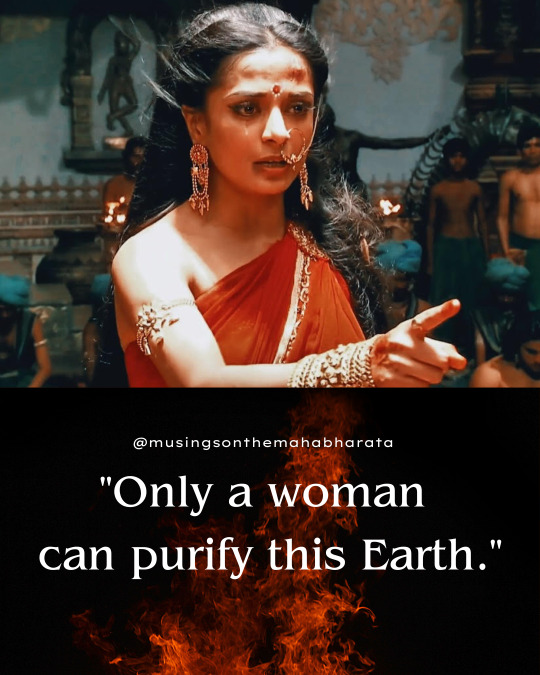

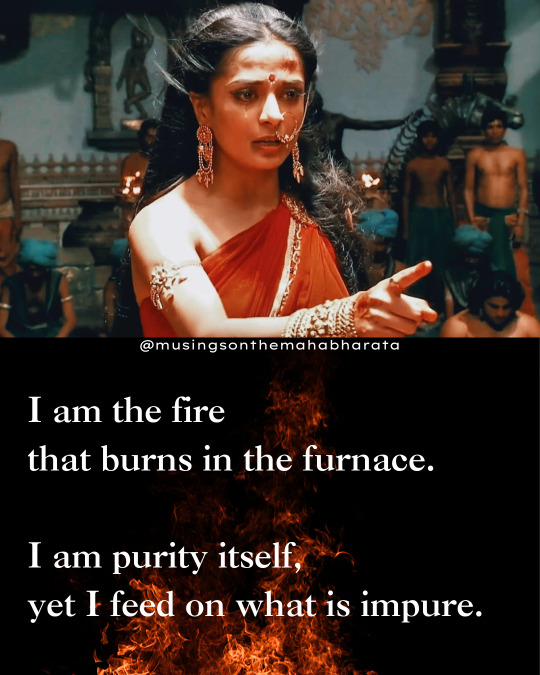
excerpt from an audio-translation I worked on with a colleague of mine; we translated Draupadī's imposing speech as rendered in modern Mahābhārat retellings. Draupadī utters this speech after she is dragged to the royal hall by her hair, and is assaulted & sexually harassed by the men of the Kuru dynasty. she renounces her status as a wife; in the Sanskrit Mbh, symbolically, by refusing to tie her hair again, while in modern renderings, explicitly, by directly renouncing her husbands who passively watched her humiliation.
in this sequence, Draupadī curses the Kurus. the curse bears similarities across the Sanskrit & modern tellings; that just as she bled in the sabhā (royal court / hall), so will all the men bleed on the battlefield, and just as she wept with her hair untied, so will their women cry before their corpses with their hair dishevelled (tied hair was the marking of a wife / bride, untied hair, of a widow).
photo: Pooja Sharma as Draupadī. Pooja is my Draupadī.
#mahabharata#mahabharat#mahabharatam#mahabharata art#pooja sharma#mahabharat star plus#sabha#draupadi's disrobing#draupadi#yajnaseni#hinduism#hindu mythology#itihasa#sanskrit#goddess#shakti#kauravas#kuru dynasty#krishna#sanatana dharma#religion
114 notes
·
View notes
Text
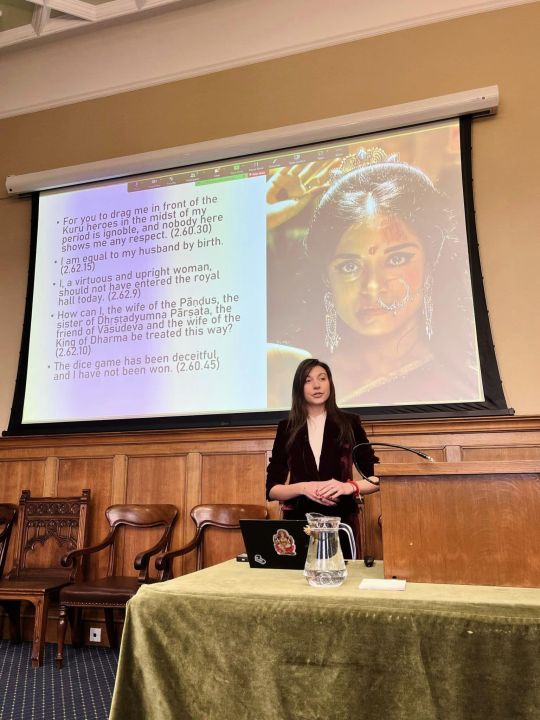
a joy to present my PhD work at the School of Divinity [Edinburgh] yesterday on my first research panel 😊 i talked about the gendered politics inscribed in the body of Draupadī, the Mahābhārata's heroine. i argued that it is significant that a text such as the Mahābhārata, which holds so much religious, cultural and spiritual weight, includes the story of a sexually assaulted woman, and, moreover, one of divine origin, because it offers women subjected to gendered violence the opportunity to unearth psychological comfort in Draupadī's story, and the opportunity to shed shame and fears of impurity rooted in varied internalisations of social or religious messages. through the prism of shared experience, the trauma is voiced and processed, which percolates in the social stratum, where, by claiming and reimagining Draupadī's symbol, women ask for and enact socio-political change. i am exploring this movement in my thesis. ❤️🔥
astounding to listen to & learn from the presentations of the colleagues who shared the panel with me, and to engage with the work differently during the q&a portion; openings to approach the work differently, freshly, in ways i wouldn't be prone to without external stimulus.
thank you @ishitahp for the photos & video! 🫶
#draupadi#mahabharata#mahabharat#phd#phd student#academia#women in academia#mahabharatam#yajnaseni#religion#gender#feminism#female empowerment#female experience#itihasa#hinduism#south asia#pooja sharma#draupadi art#draupadi's disrobing#krishna
13 notes
·
View notes
Text
Carnatic Music and Spirituality
Did you know that Carnatic Music is essentially spiritual in nature? Did you know that Carnatic music has the potential to activate your Kundalini? This understanding has unfortunately been lost to a great extent, so this can come as a surprise to many of you.

Have you visited some of the great South Indian temples? If you have, you must have noticed gigantic pillars and carvings depicting characters from Puranas/Itihasas made of stone and metal in many of those temples, vibrating with musical notes.
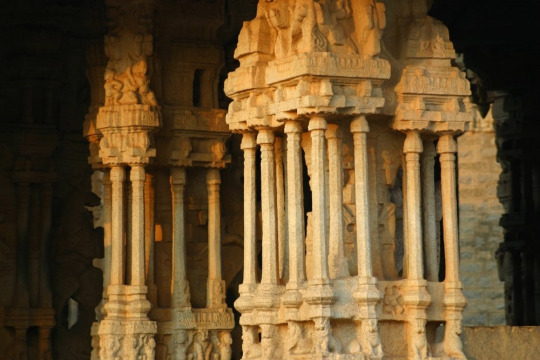
Look at Hindu deities to see how our fine arts and culture are inextricably connected. While Lord Nataraja portrays the evolution of life through his cosmic dance, Lord Krishna captivates all creation with his flute whereas Goddess Saraswati carries a Veena in her arms.
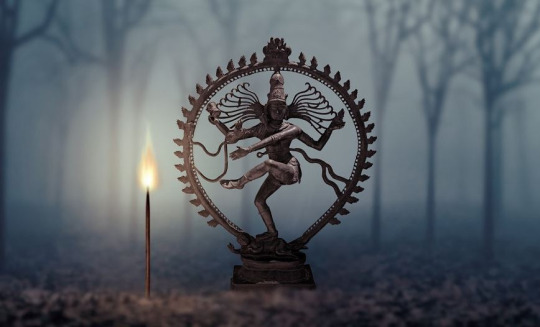
Thanks to our great ancestors, Indian classical music was woven into the texture of Hindu culture, religion, and yoga sadhana. The great composers of Carnatic music were men and women of saintly character, mystics, Siddhas, and bhaktas.

The goal of every life is God realization/mukthi or moksha. Our ancestors knew this more than anyone else, and so all activities were dedicated to the service of God. In their search for efficient sadhana to achieve this objective, our ancestors discovered that music had great disciplinary value and power to sublimate passions and attune the mind.
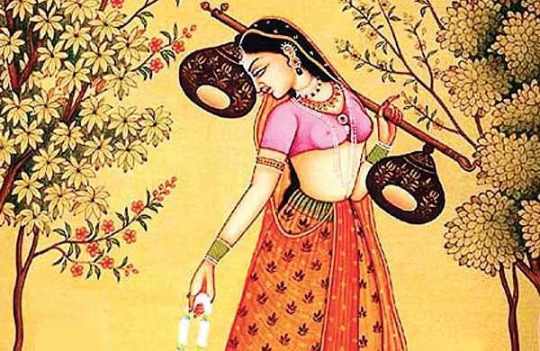
They also found that music could kindle the various subtle forces in the human body like the Kundalini. Something as powerful as this, needed to be given an elevated status. Carnatic music, therefore, started being referred to as Upa Veda, Gandharva Nada Vidya, Nada Upasana and so on. The learned men in ancient India developed Carnatic music as a tool to assist a man in his quest for Moksha.
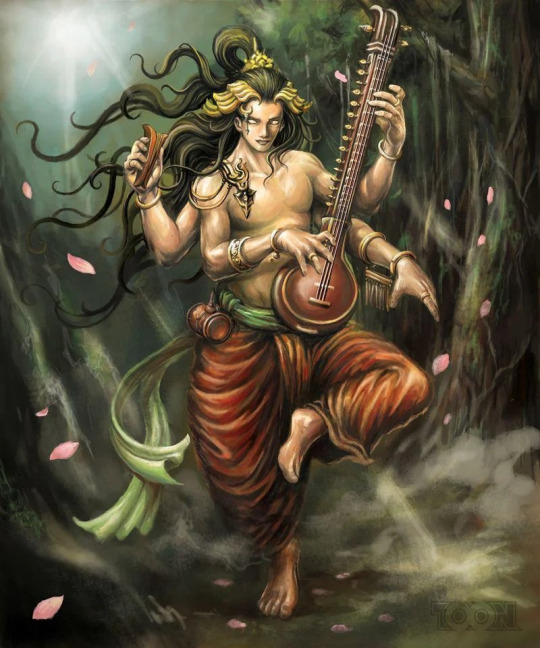
2 notes
·
View notes
Text
Indic academy initiative for publishing content on Shastraas, Indic Knowledge Systems & Indology and to showcase the activities of Indic Academy.
Visit us:
https://www.indica.today/
#Shastraas#Indic Knowledge Systems#Indology#Indic academy#Indica Today#Shastra#Shastrartha#Itihasa#Purana#Adhyayana#Svadhyaya#Pauranika#Yoga#Sankhya#Nyaya#Mimamsa#Tarka
0 notes
Text
శ్రీ లలితా చైతన్య విజ్ఞానము - 539 - 8 / Sri Lalitha Chaitanya Vijnanam - 539 - 8
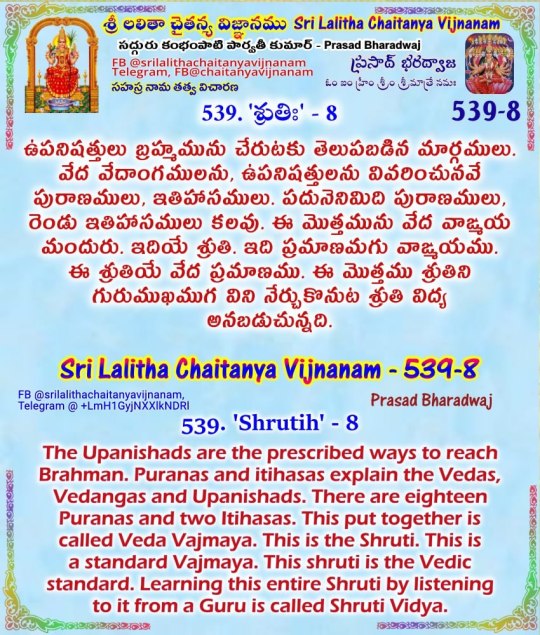
🌹. శ్రీ లలితా చైతన్య విజ్ఞానము - 539 - 8 / Sri Lalitha Chaitanya Vijnanam - 539 - 8 🌹
🌻. లలితా సహస్ర నామముల తత్వ విచారణ 🌻
✍️. సద్గురు శ్రీ కంభంపాటి పార్వతీ కుమార్
సేకరణ : ప్రసాద్ భరద్వాజ
🍁. మూల మంత్రము : ఓం ఐం హ్రీం శ్రీం శ్రీమాత్రే నమః 🍁
🍀 110. సర్వౌదన ప్రీతచిత్తా, యాకిన్యంబా స్వరూపిణీ ।
స్వాహా, స్వధా, అమతి, ర్మేధా, శ్రుతిః, స్మృతి, రనుత్తమా ॥ 110 ॥ 🍀
🌻 539. 'శ్రుతిః' - 8 🌻
ఉపనిషత్తులు బ్రహ్మమును చేరుటకు తెలుపబడిన మార్గములు. వేద వేదాంగములను, ఉపనిషత్తులను వివరించునవే పురాణ ములు, ఇతిహాసములు. పదునెనిమిది పురాణములు, రెండు ఇతిహాసములు కలవు. ఈ మొత్తమును వేద వాఙ్మయ మందురు. ఇదియే శ్రుతి. ఇది ప్రమాణమగు వాఙ్మయము. ఈ శ్రుతియే వేద ప్రమాణము. ఈ మొత్తము శ్రుతిని గురుముఖముగ విని నేర్చుకొనుట శ్రుతి విద్య అనబడుచున్నది.
సశేషం...
🌹 🌹 🌹 🌹 🌹
🌹 Sri Lalitha Chaitanya Vijnanam - 539 - 8 🌹
Contemplation of 1000 Names of Sri Lalitha Devi
✍️ Prasad Bharadwaj
🌻 110. Sarvaodana pritachitta yakinyanba svarupini
svahasvadha amati rmedha shrutih smrutiranuttama ॥110 ॥ 🌻
🌻 539. 'Shrutih' - 8 🌻
The Upanishads are the prescribed ways to reach Brahman. Puranas and itihasas explain the Vedas, Vedangas and Upanishads. There are eighteen Puranas and two Itihasas. This put together is called Veda Vajmaya. This is the Shruti. This is a standard Vajmaya. This shruti is the Vedic standard. Learning this entire Shruti by listening to it from a Guru is called Shruti Vidya.
Continues...
🌹 🌹 🌹 🌹 🌹
#శ్రీ లలితా చైతన్య విజ్ఞానము#prasad bharadwaj#lalitha chaitanya sahasranama contemplation#lalita devi#lalitha devi#lalitha
0 notes
Note
i'd just like to kindly add women like draupadi and others in the mahabharata or ramayana are not "characters". she was written in the itihasas, and thus she is embedded in hindu history, she walked this earth.
let's decolonize ourselves from referring to historical dharmic people as "mythological" as this plays right into the hands of how western and islamic academic institutions including the far left wing demonize and frame our culture, history and people.
jai shri ram.
Very true, it takes a lot to unlearn the things we've been taught. I also keep correcting myself everytime I refer to our history as mythology. Thank you for the reminder!
Jai shri ram
4 notes
·
View notes
Text
West singhbhum itihasa sankirtan : चक्रधरपुर के इटिहासा के हरिनाम संकीर्तन में पहुंचे राज्य अल्पसंख्यक आयोग के पूर्व उपाध्यक्ष अशोक षाड़ंगी, पूजा अर्चना कर लिया आशीर्वाद, क्षेत्र की सुख-समृद्धि के लिए की प्रार्थना
रामगोपाल जेना/चक्रधरपुर : पश्चिमी सिंहभूम जिले के चक्रधरपुर प्रखंड अंतर्गत इटिहासा गांव में आयोजित 48 प्रहरी हरिनाम संकीर्तन में राज्य अल्पसंख्यक आयोग के पूर्व उपाध्यक्ष अशोक षाड़ंगी एवं भाजपा नेता राजू प्रसाद कसेरा पहुंचे और पूजा अर्चना कर प्रभु राधा-कृष्ण की पूजा अर्चना कर आशीर्वाद लिया एवं क्षेत्र के सुख-समृद्धि एवं खुशहाली की कामना की. 25 मार्च से आरंभ हुआ संकीर्तन बुधवार 27 मार्च को संपन्न…

View On WordPress
0 notes